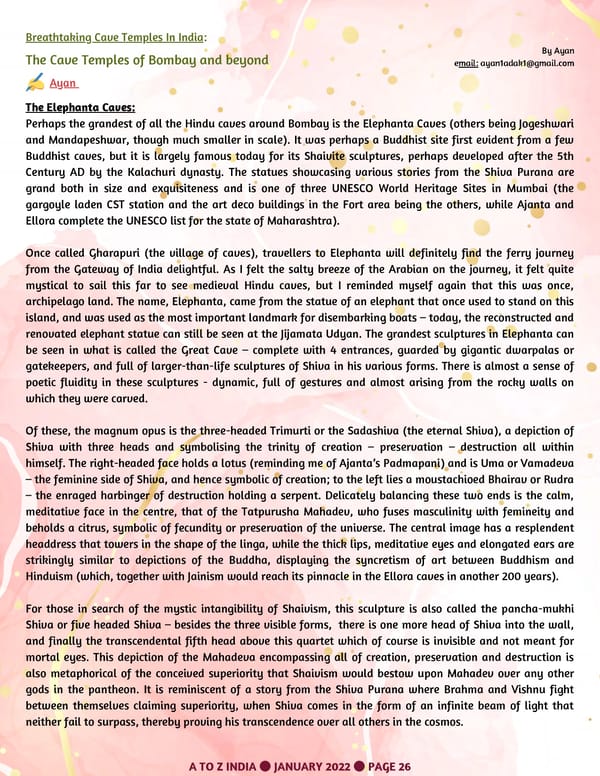Breathtaking Cave Temples In India: By Ayan The Cave Temples of Bombay and beyond email: [email protected] Ayan The Elephanta Caves: Perhaps the grandest of all the Hindu caves around Bombay is the Elephanta Caves (others being Jogeshwari and Mandapeshwar, though much smaller in scale). It was perhaps a Buddhist site first evident from a few Buddhist caves, but it is largely famous today for its Shaivite sculptures, perhaps developed after the 5th Century AD by the Kalachuri dynasty. The statues showcasing various stories from the Shiva Purana are grand both in size and exquisiteness and is one of three UNESCO World Heritage Sites in Mumbai (the gargoyle laden CST station and the art deco buildings in the Fort area being the others, while Ajanta and Ellora complete the UNESCO list for the state of Maharashtra). Once called Gharapuri (the village of caves), travellers to Elephanta will definitely find the ferry journey from the Gateway of India delightful. As I felt the salty breeze of the Arabian on the journey, it felt quite mystical to sail this far to see medieval Hindu caves, but I reminded myself again that this was once, archipelago land. The name, Elephanta, came from the statue of an elephant that once used to stand on this island, and was used as the most important landmark for disembarking boats – today, the reconstructed and renovated elephant statue can still be seen at the Jijamata Udyan. The grandest sculptures in Elephanta can be seen in what is called the Great Cave – complete with 4 entrances, guarded by gigantic dwarpalas or gatekeepers, and full of larger-than-life sculptures of Shiva in his various forms. There is almost a sense of poetic fluidity in these sculptures - dynamic, full of gestures and almost arising from the rocky walls on which they were carved. Of these, the magnum opus is the three-headed Trimurti or the Sadashiva (the eternal Shiva), a depiction of Shiva with three heads and symbolising the trinity of creation – preservation – destruction all within himself. The right-headed face holds a lotus (reminding me of Ajanta’s Padmapani) and is Uma or Vamadeva – the feminine side of Shiva, and hence symbolic of creation; to the left lies a moustachioed Bhairav or Rudra – the enraged harbinger of destruction holding a serpent. Delicately balancing these two ends is the calm, meditative face in the centre, that of the Tatpurusha Mahadev, who fuses masculinity with femineity and beholds a citrus, symbolic of fecundity or preservation of the universe. The central image has a resplendent headdress that towers in the shape of the linga, while the thick lips, meditative eyes and elongated ears are strikingly similar to depictions of the Buddha, displaying the syncretism of art between Buddhism and Hinduism (which, together with Jainism would reach its pinnacle in the Ellora caves in another 200 years). For those in search of the mystic intangibility of Shaivism, this sculpture is also called the pancha-mukhi Shiva or five headed Shiva – besides the three visible forms, there is one more head of Shiva into the wall, and finally the transcendental fifth head above this quartet which of course is invisible and not meant for mortal eyes. This depiction of the Mahadeva encompassing all of creation, preservation and destruction is also metaphorical of the conceived superiority that Shaivism would bestow upon Mahadev over any other gods in the pantheon. It is reminiscent of a story from the Shiva Purana where Brahma and Vishnu fight between themselves claiming superiority, when Shiva comes in the form of an infinite beam of light that neither fail to surpass, thereby proving his transcendence over all others in the cosmos. A TO Z INDIA ● JANUARY 2022 ● PAGE 26
 A TO Z INDIA - JANUARY 2023 Page 25 Page 27
A TO Z INDIA - JANUARY 2023 Page 25 Page 27